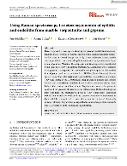| dc.contributor.author | Jehlička, Jan | |
| dc.contributor.author | Culka, Adam | |
| dc.contributor.author | Němečková, Kateřina | |
| dc.contributor.author | Mareš, Jan | |
| dc.date.accessioned | 2024-03-14T16:40:33Z | |
| dc.date.available | 2024-03-14T16:40:33Z | |
| dc.date.issued | 2023 | |
| dc.identifier.uri | https://hdl.handle.net/20.500.14178/2399 | |
| dc.description.abstract | Here, we present Raman spectra showing the presence and distribution of scytonemin and carotenoids in epilithic and endolithic colonisations from temperate locations in Central Europe and Sicily. In the Bohemian Massif, marble and serpentinitic cyanobacterial epiliths dominated by cyanobacteria Scytonema, Stigonema, Hassallia, Gloeocapsopsis and Gloeocapsa were investigated using light microscopy and Raman spectroscopy. Scytonemin was a common dark pigment, accompanied by carotenoids and gloeocapsin on the marbles from Opolenec and on serpentinites from Holubov (South Bohemia). Raman spectra from other sites originated from endolithic colonisations of gypsum. They were located in the Carpathian foredeep (Badenian, Silesian unit, eastern Poland) and in Messinian complexes in the Mediterranean area (Sicily). Similarly to the previous localities, almost ubiquitous occurrence of scytonemin confirmed the presence of cyanobacterial colonisations. Obtained findings are important from the spectroscopic point of view. Additionally, comparing results from several sites confirmed the common occurrence of scytonemin in both endoliths and epiliths from areas that cannot be considered climatically extreme, although they experience rapid fluctuations in temperature, humidity and UV irradiation on the exposed rocky substrates. | en |
| dc.language.iso | en | |
| dc.relation.url | https://doi.org/10.1002/jrs.6514 | |
| dc.rights | Creative Commons Uveďte původ 4.0 International | cs |
| dc.rights | Creative Commons Attribution 4.0 International | en |
| dc.title | Using Raman spectroscopy to detect scytonemin of epiliths and endoliths from marble, serpentinite and gypsum | en |
| dcterms.accessRights | openAccess | |
| dcterms.license | https://creativecommons.org/licenses/by/4.0/legalcode | |
| dc.date.updated | 2024-04-23T21:40:33Z | |
| dc.subject.keyword | cyanobacteria | en |
| dc.subject.keyword | endolithic colonisations | en |
| dc.subject.keyword | epilithic colonisations | en |
| dc.subject.keyword | Raman spectra | en |
| dc.subject.keyword | scytonemin | en |
| dc.relation.fundingReference | info:eu-repo/grantAgreement/UK/COOP/COOP | |
| dc.relation.fundingReference | info:eu-repo/grantAgreement/UK/UNCE/SCI/UNCE/SCI/006 | |
| dc.relation.fundingReference | info:eu-repo/grantAgreement/GA0/GA/GA21-03322S | |
| dc.date.embargoStartDate | 2024-04-23 | |
| dc.type.obd | 73 | |
| dc.type.version | info:eu-repo/semantics/publishedVersion | |
| dc.identifier.doi | 10.1002/jrs.6514 | |
| dc.identifier.utWos | 000960186100001 | |
| dc.identifier.eidScopus | 2-s2.0-85152070859 | |
| dc.identifier.obd | 646073 | |
| dc.subject.rivPrimary | 10000::10500::10505 | |
| dcterms.isPartOf.name | Journal of Raman Spectroscopy | |
| dcterms.isPartOf.issn | 0377-0486 | |
| dcterms.isPartOf.journalYear | 2023 | |
| dcterms.isPartOf.journalVolume | 54 | |
| dcterms.isPartOf.journalIssue | 11 | |
| uk.faculty.primaryId | 115 | |
| uk.faculty.primaryName | Přírodovědecká fakulta | cs |
| uk.faculty.primaryName | Faculty of Science | en |
| uk.department.primaryId | 1063 | |
| uk.department.primaryName | Ústav geochemie, mineralogie a nerostných zdrojů | cs |
| uk.department.primaryName | Institute of Geochemistry, Mineralogy and Mineral Resources | en |
| dc.description.pageRange | 1280-1296 | |
| dc.type.obdHierarchyCs | ČLÁNEK V ČASOPISU::článek v časopisu::původní článek | cs |
| dc.type.obdHierarchyEn | JOURNAL ARTICLE::journal article::original article | en |
| dc.type.obdHierarchyCode | 73::152::206 | en |
| uk.displayTitle | Using Raman spectroscopy to detect scytonemin of epiliths and endoliths from marble, serpentinite and gypsum | en |

